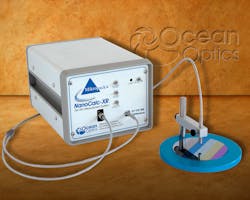NanoCalc systems utilize spectroscopic reflectometry to determine optical thin-film thicknesses. They are available for a range of wavelengths, sampling method, and optical layer thickness requirements from 1.0 nm to 250 μm. Users can select among four standard models between 200 and 1700 nm and combine them with software, reflection probes, optical fibers, and various accessories. Pre-configured models are also available.
Ocean Optics
Dunedin, FL
www.oceanoptics.com
-----
PRESS RELEASE
Precision Thin Films Analysis with Ocean Optics NanoCalc Systems
Multiple thin film reflectometry options from deep ultraviolet to near infrared
Dunedin, FL – Ocean Optics’ (www.OceanOptics.com) NanoCalc systems utilize spectroscopic reflectometry to accurately determine optical thin film thicknesses for consumer, semiconductor, medical and industrial applications. Customer-designed and new application-ready preconfigured NanoCalc models make it easy to select the optimum system for deep UV to NIR wavelength measurement needs.
NanoCalc systems are available for a range of wavelength, sampling method and optical layer thickness requirements (from 1.0 nm to 250 µm). Users can select among four standard models between ~200-1700 nm and combine them with software, reflection probes, optical fibers and various accessories. For applications in the Visible (400-850 nm) or UV-Visible (250-1050 nm), users have the added convenience of selecting preconfigured systems comprising the NanoCalc, a reflection probe and sampling stage, a calibrated Si-SiO2 5-step reference wafer and software that analyzes up to 10 optical layers.
For more demanding applications, NanoCalc systems are available with an extensive range of add-on software, optical fibers and metrology accessories such as mapping stages and adapters for microscopes and micro-spot focusing objectives.
NanoCalc systems are especially useful for applications such as transmission and reflection measurements of anti-reflective and hardness coatings, amorphous silicon on solar panels, OLED displays, determination of photoresist layers for photomasks and testing the optical properties of optical coatings.
Custom NanoCalc systems are also available, offering additional user control for in situ, multipoint or vacuum measurements. Users have flexibility in their choice of fiber assemblies or reflection probes. Also, users can control NanoCalc functions from other software or operate mapping stages with software add-ons including remote, online, mapping and multi-layer options.
To learn more about the NanoCalc System options, visit www.OceanOptics.com, or call +1 727-733-2447.
-----
Subscribe now to Laser Focus World magazine; it's free!
